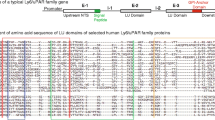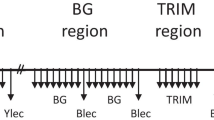Abstract
Mouse complement component C1q is a serum glycoprotein which consists of six A chains, six B chains and six C chains. The three polypeptides are 223, 228, and 217 residues long, respectively, and are encoded by three genes. DNA probes for mouse C1q A, B, and C chains were hybridized to Southern blots of DNA obtained from various inbred mouse strains. On the basis of fragment length polymorphisms, two different alleles of each of the genes could be identified. The distribution of these alleles was determined in the BXD and LXPL recombinant inbred strain series. Comparison with previously reported strain distribution patterns shows that the genes encoding mouseClq map to the same locus on distal chromosome 4. Overlapping clones spanning the entire gene cluster ofClq were isolated from genomic libraries using specific cDNA probes. The three genesClqA, ClqB, andClqC are closely arranged on a 19 kilobase stretch of DNA in the 5′ to 3′ orientation A-C-B. Each gene consists of two exons separated by one intron. Sequence comparison of Clq from three different species have shown that the B chains have the strongest similarity. Southern blot analysis of chromosomal DNA from 14 vertebrate species demonstrated highest similarity between theClqB genes, followed byClqC and finallyClqA.
Similar content being viewed by others
References
Alexander, R. J. and Steiner, L. A. The first component of complement from the bullfrog,Rana catesbeiana: functional properties of C1 and isolation of subcomponent Clq.J Immunol 124: 1418–1425, 1980
Blatt, C., Mileham, K., Haas, M., Nesbitt, M. N., Harper, M. E., and Simon, M. I. Chromosome mapping of mink cell focus-inducing and xenotropic env gene family in the mouse.Proc Natl Acad Sci USA 80: 6298–6302, 1983
Bolton, E. T. and McCarthy, B. J. A general method for the isolation of RNA complementary to DNA.Proc Natl Acad Sci USA 48: 1390–1397, 1962
Bonner, T. I., Brenner, D. J., Neufeld, B. R., and Britten, R. J. Reduction in the rate of DNA reassociation by sequence divergence.J Mol Biol 81: 123–135, 1973
Bucher, P. Weight matrix description of four eukaryotic RNA polymerase II promoter elements derived from 502 unrelated promotor sequences.J Mol Biol 212: 563–578, 1990
Cornall, R. J., Aitman, T. J., Hearne, C. M., and Todd, J. A. The generation of a library of PCR-analysed microsatellite variants for genetic mapping of the mouse genome.Genomics 10: 874–881, 1991
Ishikawa, N., Nonaka, M., Wetsel, R. A., and Colten, H. R. Murine complement C2 and factor B genomic and cDNA cloning reveals different mechanisms for multiple transcripts of C2 and B.J Biol Chem 265: 19040–19046, 1990
Jeanpierre, M. A rapid method for the purification of DNA from blood.Nucleic Acids Res 15: 9611, 1987
Jiang, H., Siegel, J. N., and Gewurz, H. Binding and complement activation by C-reactive protein via the collagen-like region of Clq and inhibition of these reactions by monoclonal antibodies to C-reactive protein and Clq.J Immunol 146: 2324–2330, 1991
Jiang, H., Cooper, B., Robey, F. A., and Gewurz, H. DNA binds and activates complement via residues 14-26 of the human Clq A chain.J Biol Chem 267: 25597–25601, 1992
Kaul, M. and Loos, M. Clq, the collagen-like subcomponent of the first component of complement Cl, is a membrane protein of guinea pig macrophages.Eur J Immunol 3: 2166–2174, 1993
Maeurer, M. J., Trinder, P K. E., Störkel, S., and Loos, M. Modulation of type II collagen-induced arthritis in DBA/1 mice by intravenous application of a peptide from the C1q-A chain.Immunobiology 185: 103–120, 1992
Maniatis, T., Fritsch, E. F., and Sambrook, J. Molecular Cloning: A Laboratory Manual, Cold Spring Harbor Laboratory, Cold Spring Harbor, 1982
McAdam, R. A., Goundis, D., and Reid, K. B. M. A homozygous point mutation results in a stop codon in the C1q- B-chain of a C1q-deficient individual.Immunogenetics 27: 259–264, 1988
Petry, F., Reid, K. B. M., and Loos, M. Molecular cloning of the complementary DNA coding for the B-chain of murine Clq.FEBS Lett 258: 89–93, 1989
Petry, F., Reid, K. B. M., and Loos, M. Gene expression of the A- and B-chain of mouse Clq in different tissues and the characterization of the recombinant A-chain.J Immunol 147: 3988–3993, 1991
Petry, F., Reid, K. B. M., and Loos, M. Isolation, sequence analysis and characterization of cDNA clones coding for the C chain of mouse Clq: sequence similarity of complement subcomponent Clq, collagen type VIII and type X and precerebellin.Eur J Biochem 209, 129–134, 1992
Petry, F., Le, D. T., Kirschfink, M., and Loos, M. Nonsense and missense mutations in the structural genes of complement component Clq A and C chains are linked with two different types of complete selective Clq deficiencies.J Immunol 155: 4734–4738, 1995
Reddy, K. J., Kuwabara, T., and Sherman, L. A. A simple and efficient procedure for the isolation of high-quality phage lambda DNA using DEAE-cellulose column.Anal Biochem 168: 324–331, 1988
Reid, K. B. M. Molecular cloning and characterization of the complementary DNA and gene coding for the B-chain of subcomponent Clq of the human complement system.Biochem J 231: 729–735, 1985
Reid, K. B. M. and Porter, R. R. Subunit composition and structure of subcomponent Clq of the first component of human complement.Biochem J 155: 19–23, 1976
Reid, K. B. M. and Campbell, R. D. Structure and organisation of complement genes. In K. Whaley, M. Loos, and J. Weiler (eds.):Complement in Health and Disease, pp. 89–125, Kluwer Academic Publications, Dordrecht, 1993
Sanger, F., Nicklen, S., and Coulson, A. R. DNA sequencing with chain-terminating inhibitors.Proc Natl Acad Sci USA 74: 5463–5467, 1977
Schwaeble, W., Schaefer, K.-H., Petry, F., Fink, T., Knebel, D., Weihe, E., and Loos, M. Follicular dendritic cells, interdigitating cells and cells of the monocyte-macrophage-linege are the Clq-producing sources in the spleen: identification of specific cell types by in situ hybridization and immunohistochemical analysis.J Immunol 155: 4971–4978, 1995
Sellar, G. C., Blake, D. J., and Reid, K. B. M. Characterisation and organisation of the genes encoding the A, B and C chain of human C1q. The complete derived amino acid sequence of human Clq.Biochem J 274: 481–490, 1991
Sellar, G. C., Cockburn, D., and Reid, K. B. M. Localization of the gene cluster encoding the A, B, and C chains of human Clq to 1p34.1-1p36.3.Immunogenetics 35: 214–216, 1992
Silver, J. Confidence limits for estimates of gene linkage based on analysis of recombinant inbred strains.J Hered 76: 436–440, 1985
Smith, M., Griffith, C. A., Murray, J. C., Buetow, K., Emanuel, B. S., Henthorn, P S., and Harris, H. Regional assignment of the gene for human liver/bone/kidney type alkaline phosphatase to chromosome 1p36.1-1p34.Genomics 2: 139–143, 1988
Tada, N., Kimura, S., Lam, Y. L., and Hammerling, U. A new lymphocyte surface antigen controlled by a gene closely linked to theAkp-2 locus on mouse chromosome 4.Immunogenetics 20: 589–592, 1984
Taylor, B. Recombinant inbred strains. In: M. F. Lyon and R. G. Searle (eds.):Genetic Variants and Strains of the Laboratory Mouse, pp. 773–796, Oxford University Press, New York, 1989
Watanabe, K., Maruyama, N., and Elliott, R. M. Mapping of the mouse peptidylarginine deiminase gene to chr 4.Mouse Genome 91: 444–445, 1992
Wilcox, F. H. and Taylor, B. A. Genetics of the Akp-2 locus for alkaline phosphatase of liver, kidney, bone and placenta in the mouse.J Hered 72: 387–390, 1981
Wood, L., Pulaski, S., and Vogeli, G. cDNA clones coding for the complete murine B chain of complement Clq: nucleotide and derived amino acid sequence.Immunol Lett 17: 115–120, 1988
Ying, S. C., Gewurz, A. T., Jiang, H., and Gewurz, H. Human amyloid P component oligomers bind and activate the classical complement pathway via residues 14–26 and 76–92 of the A chain collagenlike region of Clq.J Immunol 150: 169–176, 1993
Author information
Authors and Affiliations
Additional information
The nucleotide sequence data reported in this paper have been submitted to the EMBL, GenBank, and DDBJ nucleotide sequence databases and have been assigned the accession numbers X92958 (ClqA), X92959 (ClqB), and X92960 (ClqC)
Rights and permissions
About this article
Cite this article
Petry, F., McClive, P.J., Botto, M. et al. The mouseClq genes are clustered on chromosome 4 and show conservation of gene organization. Immunogenetics 43, 370–376 (1996). https://doi.org/10.1007/BF02199805
Received:
Revised:
Issue Date:
DOI: https://doi.org/10.1007/BF02199805




